| This article needs additional citations for verification. Please help improve this article by adding citations to reliable sources. Unsourced material may be challenged and removed. Find sources: "Amarna Period" – news · newspapers · books · scholar · JSTOR (July 2010) (Learn how and when to remove this message) |
The Amarna Period was an era of Egyptian history during the later half of the Eighteenth Dynasty when the royal residence of the pharaoh and his queen shifted from the old capital of Thebes (Waset) to Akhetaten (literally 'Horizon of the Aten') in what is now modern Amarna. This move occurred during the reign of Amenhotep IV, who changed his name to Akhenaten (1353–1336 BC) in order to reflect the dramatic change of Egypt's polytheistic religion into one where the sun disc Aten was worshipped over all other gods. Toward the end of a Akhenaten's reign, he had a mysterious co-regent, Smenkhkare, about which very little is known; similarly, Neferneferuaten, a female ruler (perhaps the wife of Smenkhkare, or even Nefertiti herself?) also exercised influence.
Akhenaten, Smenkhkare, and Neferneferuaten were succeeded by Akhenaten's son Tutankhamun, only around nine-years old. The Egyptian pantheon was swiftly restored under his reign. Due to his youth, his viziers and advisors appear to have done most of the job of governance. Much of the government moved to Memphis, Egypt during Tutankhamun's reign, reducing Akhetaten's importance. Both of Tutankhamun's daughters predeceased him, and he died without an heir; he was succeeded as Pharoh by Ay. Ay's short reign of three years was followed by Horemheb, who ordered the city of Akhetaten torn down. Horemheb excised as much of the Amarna Period as he could from official histories and monuments, considering it an aberration. According to Horemheb's revised monuments, he directly succeeded Amenhotep III, essentially erasing 30 years of history.
Religious developments
Akhenaten instigated the earliest verified expression of a form of monotheism, although the origins of a pure monotheism are the subject of continuing debate within the academic community. Some state that Akhenaten restored monotheism while others point out that he merely suppressed a dominant solar cult by the assertion of another, while never completely abandoning several other traditional deities. Scholars believe that Akhenaten's devotion to his deity, Aten, offended many in power below him, which contributed to the end of this dynasty; he later suffered damnatio memoriae. Although modern students of Egyptology consider the monotheism of Akhenaten the most important event of this period, the later Egyptians considered the so-called Amarna period an unfortunate aberration.
The period saw many innovations in the name and service of religion. Egyptians of the time viewed religion and science as one and the same. Previously, the presence of many gods explained the natural phenomena, but during the Amarna period there was a rise in monotheism. With people beginning to think of the origins of the universe, Amun-Re was seen as the sole creator and Sun-god. The view of this god is seen through the poem entitled "Hymn to the Aten":
When your movements disappear and you go to rest in the Akhet, the land is in darkness, in the manner of death... darkness a blanket, the land in stillness, with the one who makes them at rest in his Akhet. The land grows bright once you have appeared in the Akhet, shining in the sun disk by day. When you dispel darkness and give your rays, the Two Lands are in a festival of light.
From the poem, one can see that the nature of the god's daily activity revolves around recreating the earth on a daily basis. It also focuses on the present life rather than on eternity.
After the Amarna reign, these religious beliefs fell out of favor. It has been argued that this was in part because only the king and his family were allowed to worship Amun-Re directly, while others were permitted only to worship the king and his family.
Royal women
The royal women of Amarna have more surviving text about them than any other women from ancient Egypt. It is clear that they played a large role in royal and religious functions. These women were frequently portrayed as powerful in their own right.
Queen Nefertiti was said to be the force behind the new monotheist religion. Nefertiti, whose name means "the beautiful one is here", bore six of Akhenaten's daughters.
Many of Akhenaten's daughters were as influential as, or more so than, his wives. There is a debate whether the relationship between Akhenaten and his daughters was sexual. Although there is much controversy over this topic, there is no evidence that any of them bore his children; Akhenaten did give many of his daughters titles of queen.
Art
Main article: Amarna art
During Akhenaten's reign, royal portraiture underwent dramatic change. Sculptures of Akhenaten deviate from conventional portrayal of royalty. Akhenaten is depicted in an androgynous and highly stylized manner, with large thighs, a slim torso, drooping belly, full lips, and a long neck and nose. Some believe that the break with convention was due to "the presence at Amarna of new people or groups of artists whose background and training were different from those of the Karnak sculptors." Colossi and wall-reliefs from the Karnak Aten Temple are highly exaggerated and almost grotesque when compared to the Egyptian royal and elite art during the millennium preceding Akhenaten's birth. Art before Akhenaten was characterized by its formality and restraint, and shifted toward becoming stylized.
While Akhenaten is famous for the changes he made in the religious practices and art, there were also changes in temple architecture, building methods, and public inscriptions. He shifted to smaller blocks of stone set in a strong mortar in order to create his stone structure. Official inscriptions changed from the old-fashioned language used in traditional earlier periods to monumental texts to reflect the spoken language of the time.
Tutankhamun and the Amarna succession
Main article: Amarna successionTutankhamun, among the last of his dynasty and the Amarna kings, died before he was twenty years old, and the dynasty's final years clearly were shaky. The royal line of the dynasty died out with Tutankhamun. Two babies found buried in his tomb were his infant daughters, who would have continued the royal lineage.
An unidentified Egyptian queen Dakhamunzu, widow of "King Nibhururiya", is known from Hittite annals. She is often identified as Ankhesenamun, royal wife of Tutankhamun, although Nefertiti and Meritaten have also been suggested as possible candidates. This queen wrote to Suppiluliuma I, king of the Hittites, asking him to send one of his sons to become her husband and king of Egypt. In her letters she expressed fear and a reluctance to take as husband one of her servants. Suppiluliumas sent an ambassador to investigate, and after further negotiations agreed to send one of his sons to Egypt. This prince, named Zannanza, was, however, murdered, probably en route to Egypt. Suppiluliumas reacted with rage at the news of his son's death and accused the Egyptians. Then, he retaliated by going to war against Egypt's vassal states in Syria and Northern Canaan and captured the city of Amki. Unfortunately, Egyptian prisoners of war from Amki carried a plague which eventually would ravage the Hittite Empire and kill both Suppiluliumas I and his direct successor.
The last two members of the eighteenth dynasty – Ay and Horemheb – became rulers from the ranks of officials in the royal court, although Ay may have married the widow of Tutankhamun in order to obtain power and she did not live long afterward. Ay's reign was short. His successor was Horemheb, a general in the Egyptian army, who had been a diplomat in the administration of Tutankhamun and may have been intended as his successor by Tutankhamun, who had no surviving children. Horemheb may have taken the throne away from Ay in a coup. He also died without surviving children and appointed his successor, Paramessu, who under the name Ramesses I ascended the throne in 1292 BC and was the first pharaoh of the Nineteenth Dynasty.
Foreign relations
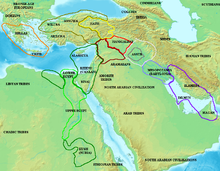
The Amarna Letters feature correspondence among the rulers of several empires, dubbed by modern historians The Club of Great Powers: Babylon, Assyria, Mitanni and Hatti, viz. the major powers in Mesopotamia, the Levant and Anatolia during the Late Bronze Age.
The Great Powers
Babylon EA 1–11

The Babylonians were conquered by an outside group of people and were referred to in the letters as Karaduniyas. Babylon was ruled by the Kassite dynasty which would later on assimilate to the Babylonian culture. The letters of correspondence between the two deal with various trivial things but it also contained one of the few messages from Egypt to another power. It was the pharaoh responding to the demands of King Kasashman-Enlil, who initially inquired about the whereabouts of his sister, who was sent for a diplomatic marriage. The king was hesitant to send his daughter for another diplomatic marriage until he knew the status of his sister. The pharaoh responds by politely telling the king to send someone who would recognize his sister. Then later correspondence dealt with the importance of exchanging of gifts namely the gold which is used in the construction of a temple in Babylonia. There was also a correspondence where the Babylonian king was offended by not having a proper escort for a princess. He wrote that he was distraught by how few chariots there were to transport her and that he would be shamed by the responses of the great kings of the region.
Assyria EA 15–16
By the time of the Amarna letters, the Assyrians, who were originally a vassal state, had become an independent power. The two letters were from king Assur-uballit I. The first dealt with him introducing himself and sending a messenger to investigate Egypt: "He should see what you are like and what your country is like, and then leave for here." (EA 15) The second letter dealt with him inquiring as to why Egypt was not sending enough gold to him and arguing about profit for the king: "Then let him (a messenger) stay out and let him die right there in the sun, but for (but) for the king himself there must be a profit."
Mittani EA 17–30
Once enemies, by the time of the Amarna letters, the Mittanni had become an ally of Egypt's. These letters were written by the King Tuiseratta and dealt with various topics, such as preserving and renewing marriage alliances, and sending in various gifts. For example, EA 22 and EA 25 in the Amarna letters are an inventory of the gifts from the Mittani king Tusratta to the pharaoh. Other correspondences of note dealt with a gold statue that was addressed in EA 26 and EA 27. Akhenaten married a Mittani princess in order to create stronger ties between the two nations.
Hatti EA 41–44
Hatti was a kingdom in central Anatolia that would later make Mitanni their vassal state. The correspondence from the Hatti comes from a king called Suppiluliuma. The subjects of the letters varied, from discussing past alliances to gift-giving and dealing with honor. In EA 42, the tablet stated how the Hittite king was offended by the name of the pharaoh written over his name. Although the ending of the text was very fragmented, it was discerned as saying that he will blot out the name of the pharaoh.
Amarna Letters
Main article: Amarna letters| This section may contain material not related to the topic of the article. Please help improve this section or discuss this issue on the talk page. (October 2012) (Learn how and when to remove this message) |
The opening statement
The opening statement:— Say to Nibmuareya, the king of Egypt, my brother: Thus Tuiseratta, the King of Mittani, your brother. For me all goes well. For you may all go well. For Kelu-Heba may all go well. For your household, for your wives, for your sons, for your magnates, for your warriors, for your horses, for your chariots, and in your country, may all go very well. |
William Moran discussed how the first line in these documents followed a consistent formula of "Say to PN. Thus PN." There are variations of this but was found common among all the tablets. The other is a salutation which is one a report of the monarch's well-being and then the second which is a series of good wishes toward the monarch. Indeed, this seems to be part of the style of Akkadian style of writing which helped facilitate foreign correspondence for the long term. As scholars argued, this aided in filtering out the chauvinistic domestic ideology at home to the other monarch. This allowed diplomacy to flourish which aided to the relative peace of the time.
Brotherhood
Despite the great distances between the rulers, the concept of a global village reigned.
As is seen in EA 7:— From the time the messenger of my brother arrived here, I have not been well, and so on no occasion has his messenger eaten food and drunk spirits in my company. If you ask... your messenger, he will tell you that I have not been well and that, as far as my recovery is concerned, I am still by no means restored to health.... I for my part became angry with my brother, saying, has my brother not heard that I am ill? Why has he shown me no concern? Why has he sent no messenger here and visited me? |
The importance of this in EA 7 is that it demonstrates the mindset of the rulers in the Near East world at the time. The "enlarged village" which scholars like to term permeated their thoughts where they took the idea of brotherhood. They were related through the political marriages but is an idea of a village of clans which gives reason to the good wishes and update on the health of the monarchs themselves. The monarchs seem to have very little concept of the time of travel between each other and at most likely saw that the village worldview they lived in was applicable for the long distant correspondence of the Amarna letters. Indeed, there is a constant demonstration of love as seen in these letters. Scholars pointed out that to demonstrate good friendship it had to be on the practical level of constant stream of gift giving. This request for gifts is constant with the various correspondence with the Great Kings.
Gallery
-
 Queen Tiye, matriarch of the Amarna Dynasty. She was the mother of Akhenaten and wife of Amenhotep III. She mainly ran Egypt's affairs of state for her son.
Queen Tiye, matriarch of the Amarna Dynasty. She was the mother of Akhenaten and wife of Amenhotep III. She mainly ran Egypt's affairs of state for her son.
-
 Akhenaten, born Amenhotep IV, began a religious revolution in which he declared Aten was a supreme god and turned his back on the old traditions. He moved the capital to Akhetaten.
Akhenaten, born Amenhotep IV, began a religious revolution in which he declared Aten was a supreme god and turned his back on the old traditions. He moved the capital to Akhetaten.
-
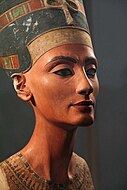 Queen Nefertiti, the daughter of Ay, married Akhenaten. Her role in daily life at the court soon extended from Great Royal Wife to that of a co-regent. It is also possible that she may have ruled Egypt in her own right as pharaoh, Neferneferuaten.
Queen Nefertiti, the daughter of Ay, married Akhenaten. Her role in daily life at the court soon extended from Great Royal Wife to that of a co-regent. It is also possible that she may have ruled Egypt in her own right as pharaoh, Neferneferuaten.
-
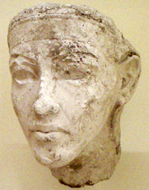 Smenkhkare, was a co-regent of Akhenaten who ruled after his death. It was believed that Smenkhkare was a male guise of Nefertiti. However, it is accepted that Smenkhkare was a male. He took Meritaten, Queen Nefertiti's daughter as his wife.
Smenkhkare, was a co-regent of Akhenaten who ruled after his death. It was believed that Smenkhkare was a male guise of Nefertiti. However, it is accepted that Smenkhkare was a male. He took Meritaten, Queen Nefertiti's daughter as his wife.
-
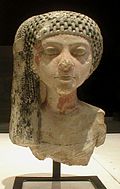 Queen Meritaten, was the oldest daughter of Akhenaten and Nefertiti. She was the wife of Smenkhkare. She also may have ruled Egypt in her own right as pharaoh and is one of the possible candidates for being the pharaoh, Neferneferuaten.
Queen Meritaten, was the oldest daughter of Akhenaten and Nefertiti. She was the wife of Smenkhkare. She also may have ruled Egypt in her own right as pharaoh and is one of the possible candidates for being the pharaoh, Neferneferuaten.
-
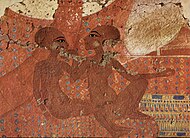 Neferneferure and Neferneferuaten Tasherit. Shown here as children, they were two of six daughters born to Akhenaten and Nefertiti. It is possible that Neferneferuaten Tasherit was the one who may have been her father's co-regent and may have ruled as the female pharaoh, Neferneferuaten.
Neferneferure and Neferneferuaten Tasherit. Shown here as children, they were two of six daughters born to Akhenaten and Nefertiti. It is possible that Neferneferuaten Tasherit was the one who may have been her father's co-regent and may have ruled as the female pharaoh, Neferneferuaten.
-
 Canopic jar lid of Kiya. She was one of Akhenaten's secondary wives. It was once believed that she was the mother of Tutankhamun, but that was proven not the case when DNA revealed it not so.
Canopic jar lid of Kiya. She was one of Akhenaten's secondary wives. It was once believed that she was the mother of Tutankhamun, but that was proven not the case when DNA revealed it not so.
-
 The Younger Lady mummy of KV35 was by DNA matching Tutankhamun's mother. Originally thought to be Nefertiti, DNA showed that she was the sister of Akhenaten. Princess Nebetah or Beketaten are considered candidates.
The Younger Lady mummy of KV35 was by DNA matching Tutankhamun's mother. Originally thought to be Nefertiti, DNA showed that she was the sister of Akhenaten. Princess Nebetah or Beketaten are considered candidates.
-
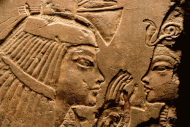 Maia was the wet nurse of the Crown Prince, Tutankhamun. Having lost his mother at a young age, she helped rear the young prince. Maia was later allowed to have a grand tomb at Saqqara. Here the young prince holds her hand.
Maia was the wet nurse of the Crown Prince, Tutankhamun. Having lost his mother at a young age, she helped rear the young prince. Maia was later allowed to have a grand tomb at Saqqara. Here the young prince holds her hand.
-
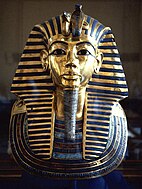 Tutankhamun, formerly Tutankhaten, was Akhenaten's son through an incestuous relationship with his sister. As pharaoh, he instigated policies to restore Egypt to its old religion and moved the capital back to Thebes.
Tutankhamun, formerly Tutankhaten, was Akhenaten's son through an incestuous relationship with his sister. As pharaoh, he instigated policies to restore Egypt to its old religion and moved the capital back to Thebes.
-
Ankhesenamun, born Ankhesenpaaten, was the wife of Tutankhamun, and daughter of Akhenaten. After her husband's death, she was married to her maternal grandfather Ay.
-
 Ay served as vizier to Akhenaten, and Tutankhamun. He was the father of Nefertiti. After the death of Tutankhamun, Ay lay a claim to the throne by burying him and by marrying his granddaughter Ankhesenamun.
Ay served as vizier to Akhenaten, and Tutankhamun. He was the father of Nefertiti. After the death of Tutankhamun, Ay lay a claim to the throne by burying him and by marrying his granddaughter Ankhesenamun.
-
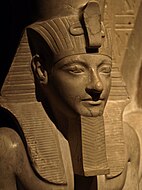 After the death of Ay, Horemheb assumed the throne. A commoner, he had served as vizier to both Tutankhamun and Ay. Horemheb instigated a policy of damnatio memoriae, against everyone associated with the Amarna period. He was married to Nefertiti's sister, Mutnodjmet, who died in child birth. With no heir, he appointed his own vizier, Paramessu as his successor.
After the death of Ay, Horemheb assumed the throne. A commoner, he had served as vizier to both Tutankhamun and Ay. Horemheb instigated a policy of damnatio memoriae, against everyone associated with the Amarna period. He was married to Nefertiti's sister, Mutnodjmet, who died in child birth. With no heir, he appointed his own vizier, Paramessu as his successor.
-
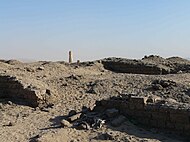 The ruins of Akhetaten. Now commonly called Amarna, Akhenaten's capital city was abandoned by Tutankhamun. It survived several years before being torn apart by Horemheb's orders.
The ruins of Akhetaten. Now commonly called Amarna, Akhenaten's capital city was abandoned by Tutankhamun. It survived several years before being torn apart by Horemheb's orders.
Notes
- ^ Arnold, Dorothea, James P. Allen, and L. Green. The Royal Women of Amarna: Images of Beauty from Ancient Egypt. New York: The Metropolitan Museum of Art, 1996. Print.
- Cothren, Michael and Stokstad, Marilyn: Art History. Prentice Hall, 2011.
- ^ "BBC - History - Ancient History in depth: Akhenaten and the Amarna Period". Bbc.co.uk. Retrieved 28 March 2019.
- "Test 1 - Art And Art History 2302 with Elkins at Baylor University". Studyblue.com. Retrieved 28 March 2019.
- Hawass, Zahi. Scanning the Pharaohs: CT Imaging of the New Kingdom Royal Mummies. pp. 107–116.
- Cline, Eric H (2014). "SUPPILULIUMA AND THE ZANNANZA AFFAIR". 1177 B.C. : the year civilization collapsed. Princeton: Princeton University Press. pp. 68–70. ISBN 978-0-691-14089-6. OCLC 861542115.
- Norrie, Philip (2016). "How Disease Affected the History of the Hittite Empire". A History of Disease in Ancient Times. Cham: Springer International Publishing. pp. 49–55. doi:10.1007/978-3-319-28937-3_4. ISBN 978-3-319-28936-6.
- ^ Liverani, Mario, "The Great Powers' Club," in Cohen & Westbrook (2000), pp. 18–19
- Moran (1992), p. 7
- Moran (1992), pp. 1–3
- Moran. Amarna Diplomacy. 21
- Moran (1992), pp. 41–42
- Cohen & Westbrook (2000), p. 6
- Moran. Amarna Diplomacy. 116
- Moran (1992), p. xxii–xxiii
- Cohen & Westbrook (2000), pp. 235–236
- Zaccagnini, Carlos, "The Interdependence of the Great Powers," in Cohen & Westbrook (2000), p. 145
References
- Cohen, Raymond; Westbrook, Raymond (2000). Amarna Diplomacy: the Beginnings of International Relations. Baltimore, MD: Johns Hopkins University Press. ISBN 0-8018-6199-3.
- Moran, William L. (1992). The Amarna Letters. Baltimore, MD: Johns Hopkins University Press. ISBN 0-8018-4251-4.
Further reading
Library resources aboutAmarna Period
- Arnold, Dorothea, James P. Allen, and L Green. 1996. The Royal Women of Amarna: Images of Beauty From Ancient Egypt. New York: The Metropolitan Museum of Art.
- Freed, Rita A., Yvonne Markowitz, and Sue H. d’Auria, eds. 1999. Pharaohs of the Sun: Akhenaten, Nefertiti, Tutankhamun. London: Thames & Hudson.
- Hari, Robert. 1985. New Kingdom Amarna Period: The Great Hymn to Aten. Leiden: E.J. Brill.
- Hornung, Erik. 1999. Akhenaten and the Religion of Light. Translated by David Lorton. Ithaca, NY: Cornell University Press.
- Kemp, Barry J. 2012. The City of Akhenaten and Nefertiti: Amarna and Its People. London: Thames & Hudson.
- Martin, Geoffrey Thorndike. 1991. A Bibliography of the Amarna Period and Its Aftermath: The Reigns of Akhenaten, Smenkhkare, Tutankhamun, and Ay (c. 1350–1321 BC). London: Kegan Paul International.
- Murnane, William J. 1995. Texts from the Amarna Period in Egypt. Edited by Edmund S. Meltzer. SBL Writings from the Ancient World 5. Atlanta: Scholars.
- Redford, Donald B. 1984. Akhenaten: The Heretic King. Princeton, NJ: Princeton University Press.
- Thomas, Angela P. 1988. Akhenaten’s Egypt. Shire Egyptology 10. Princes Risborough, UK: Shire.
External links
[REDACTED] Media related to Amarna Period at Wikimedia Commons
| Amarna Period | |||||
|---|---|---|---|---|---|
| Pharaohs |  | ||||
| Royal family |
| ||||
| |||||
| Locations | |||||
| Other | |||||